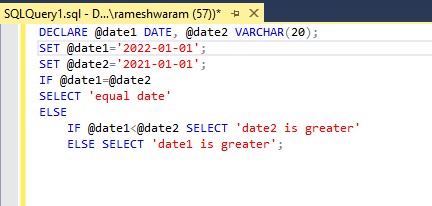Dates are a fundamental data type in SQL databases, and comparing them is a common task for anyone working with data. Whether you need to filter records within a specific time frame, identify events occurring before or after a certain date, or calculate durations, understanding how to effectively compare dates in SQL is crucial. This guide will walk you through the essentials of comparing dates in SQL, covering various techniques and considerations to help you master this essential skill.
In SQL, dates are typically stored in DATE, DATETIME, or TIMESTAMP data types, depending on the database system and the level of precision required. The standard format for dates in SQL is YYYY-MM-DD, although this can vary based on database settings and specific data types. Comparing dates in SQL is straightforward using standard comparison operators like equals to (=), less than (<), greater than (>), less than or equal to (<=), and greater than or equal to (>=). Let’s explore how to use these operators with practical examples.
Basic Date Comparison using Operators
The most fundamental way to compare dates in SQL is by directly using comparison operators. We can demonstrate this using the IF-ELSE statement, a common control flow structure in SQL, to output different messages based on the comparison result.
Syntax of IF-ELSE in SQL:
IF Boolean_expression
BEGIN
{ sql_statement | statement_block }
END
ELSE
BEGIN
{ sql_statement | statement_block }
END;Before we dive into examples, let’s quickly review how to declare and set date variables in SQL. We use the DECLARE keyword to create variables and the SET keyword to assign values to them.
Syntax to Declare Variables:
DECLARE @variable_name datatype;Syntax to Set Variable Values:
SET @variable_name = value;Now, let’s look at practical queries to compare dates.
Example 1: Comparing Two Dates for Equality
This example checks if two dates are equal.
DECLARE @date1 DATE, @date2 DATE;
SET @date1 = '2023-01-15';
SET @date2 = '2023-01-15';
IF @date1 = @date2
BEGIN
SELECT 'Dates are equal';
END
ELSE
BEGIN
SELECT 'Dates are not equal';
END;Output:
In this query, we declare two variables, @date1 and @date2, both of DATE datatype. We set them to the same date, ‘2023-01-15’. The IF condition @date1 = @date2 evaluates to true, and thus, it outputs ‘Dates are equal’.
Example 2: Comparing Dates for Greater Than or Less Than
This example demonstrates how to check if one date is earlier or later than another.
DECLARE @date1 DATE, @date2 DATE;
SET @date1 = '2023-03-20';
SET @date2 = '2023-02-28';
IF @date1 < @date2
BEGIN
SELECT 'Date 2 is greater (later)';
END
ELSE IF @date1 > @date2
BEGIN
SELECT 'Date 1 is greater (later)';
END
ELSE
BEGIN
SELECT 'Dates are equal';
END;Output:
Here, @date1 is set to ‘2023-03-20’ and @date2 to ‘2023-02-28’. The condition @date1 < @date2 is false. The ELSE IF condition @date1 > @date2 is true, resulting in the output ‘Date 1 is greater (later)’.
Example 3: Comparing Dates with Different Values
Let’s consider another scenario with different date values to reinforce the concept.
DECLARE @date1 DATE, @date2 DATE;
SET @date1 = '2022-12-01';
SET @date2 = '2023-01-10';
IF @date1 = @date2
BEGIN
SELECT 'Dates are equal';
END
ELSE IF @date1 < @date2
BEGIN
SELECT 'Date 2 is greater (later)';
END
ELSE
BEGIN
SELECT 'Date 1 is greater (later)';
END;Output:
In this case, @date1 is ‘2022-12-01’ and @date2 is ‘2023-01-10’. The condition @date1 < @date2 is true because December 2022 is before January 2023. Therefore, the output is ‘Date 2 is greater (later)’.
Beyond Basic Operators: Other Date Comparison Techniques
While the basic operators are sufficient for many date comparisons, SQL offers more advanced functions and clauses for complex scenarios.
Using BETWEEN for Date Ranges
The BETWEEN operator is ideal for checking if a date falls within a specified range.
SELECT *
FROM Orders
WHERE order_date BETWEEN '2023-01-01' AND '2023-01-31';This query selects all orders placed in January 2023.
Comparing Dates with Date Functions
SQL provides various date functions that allow you to extract specific parts of a date (year, month, day) and compare them individually. For example, to find all orders placed in a specific year:
SELECT *
FROM Orders
WHERE YEAR(order_date) = 2023;The YEAR() function extracts the year from the order_date column, which is then compared to 2023. Similar functions like MONTH(), DAY(), DATE() (to get date part from datetime), and more are available depending on your SQL database system (e.g., SQL Server, MySQL, PostgreSQL).
Using CASE Statements for Conditional Logic
The CASE statement provides another way to handle conditional logic, similar to IF-ELSE but often more flexible within a query.
SELECT
order_id,
order_date,
CASE
WHEN order_date < '2023-01-01' THEN 'Orders before 2023'
WHEN order_date >= '2023-01-01' THEN 'Orders in 2023 or later'
ELSE 'Unknown Order Date'
END AS order_category
FROM Orders;This query categorizes orders based on their order_date using a CASE statement.
Important Considerations for Date Comparisons
- Date and Datetime Types: Be mindful of the data types you are comparing. Comparing a
DATEwith aDATETIMEmight lead to unexpected results if you are not considering the time component. You might need to use date functions to truncate the time part for consistent comparisons. - Date Formats: Ensure consistency in date formats. While SQL generally handles standard ‘YYYY-MM-DD’ format, implicit conversions can sometimes lead to errors or performance issues. It’s best practice to use explicit date formats or conversion functions if needed.
- Time Zones: When dealing with
DATETIMEorTIMESTAMP, be aware of time zones. If your data spans different time zones, you might need to handle time zone conversions to ensure accurate comparisons. - Database-Specific Functions: Date functions and syntax can slightly vary across different SQL database systems (e.g., MySQL, PostgreSQL, SQL Server, Oracle). Always refer to the documentation of your specific database system for accurate function names and usage.
Conclusion
Comparing dates in SQL is a fundamental skill for data manipulation and analysis. By understanding the basic comparison operators, IF-ELSE statements, BETWEEN operator, date functions, and CASE statements, you can effectively handle a wide range of date comparison tasks. Remember to consider data types, date formats, and time zones for accurate and reliable results. Mastering these techniques will significantly enhance your ability to query and manage date-related data in SQL databases.

